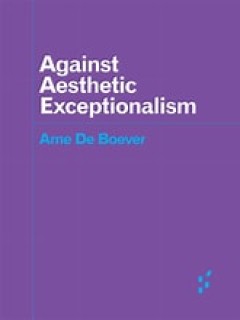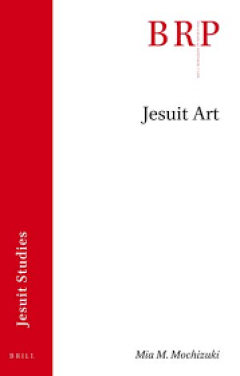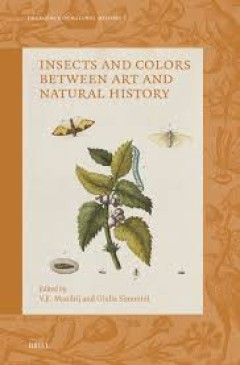Filter by

Against Aesthetic Exceptionalism
Reconsiders exceptionalism between aesthetics and politics Here, Arne De Boever proposes the notion of aesthetic exceptionalism to describe the widespread belief that art and artists are exceptional. Against Aesthetic Exceptionalism challenges that belief by focusing on the sovereign artist as genius, as well as the original artwork as the foundation of the art market. Engaging with sculpture, …
- Edition
- -
- ISBN/ISSN
- 9781452962450
- Collation
- 2019
- Series Title
- Forerunners: Ideas First
- Call Number
- -

Karel van Mander and his Foundation of the Noble, Free Art of Painting : Firs…
Written by the poet-painter Karel van Mander, who finished it in June 1603, the Grondt der edel, vry schilderconst (Foundation of the Noble, Free Art of Painting) was the first systematic treatise on schilderconst (the art of painting / picturing) to be published in Dutch (Haarlem: Paschier van Wes[t]busch, 1604). This English-language edition of the Grondt, accompanied by an introductory monog…
- Edition
- -
- ISBN/ISSN
- 978-90-04-52307-4
- Collation
- cloth with dustjacket, 484 pages, 33 full-color illustrations
- Series Title
- Brill’s Studies on Art, Art History, and Intellectual History, Volume: 62
- Call Number
- -

Karbala in the Taʿziyeh Episode, Shiʿi Devotional Drama in Iran
“I am not Shemr, this is not a dagger, nor is this Karbala,” recites the arch-antagonist as a taʿziyeh performance begins. Verisimilitude is not the endeavour; this is a devotional offering that stirs lament for the the Shiʿi martyrs by representing events crucial to sacred history. But what does that retelling entail? Through study of four of its main episodes—from their long inter-fem…
- Edition
- -
- ISBN/ISSN
- 978-90-04-71614-8
- Collation
- xii, 260 pp., incl. 11 fc illus.
- Series Title
- Studies on Performing Arts & Literature of the Islamicate World, Volume: 15
- Call Number
- -

Joost van den Vondel (1587-1679) : Dutch Playwright in the Golden Age
Joost van den Vondel (1587-1679) was the most prolific poet and playwright of his age. During his long life, roughly coinciding with the Dutch Golden Age, he wrote over thirty tragedies. He was a famous figure in political and artistic circles of Amsterdam, a contemporary and acquaintance of Grotius and Rembrandt, and in general well acquainted with Latin humanists, Dutch scholars, authors and …
- Edition
- -
- ISBN/ISSN
- 978-90-04-21883-3
- Collation
- -
- Series Title
- Drama and Theatre in Early Modern Europe, Volume: 1
- Call Number
- -

Jesuit Art : Brill's Research Perspectives in Jesuit Studies
In Jesuit Art, Mia Mochizuki considers the artistic production of the pre-suppression Society of Jesus (1540–1773) from a global perspective. Geographic and medial expansion of the standard corpus changes not only the objects under analysis, it also affects the kinds of queries that arise. Mochizuki draws upon masterpieces and material culture from around the world to assess the signature str…
- Edition
- -
- ISBN/ISSN
- 978-90-04-49822-8
- Collation
- vi, 220 pp.
- Series Title
- Brill Research Perspectives in Humanities and Social Sciences Brill Research Perspectives in Jesuit Studies
- Call Number
- -

Jacopo Strada and Cultural Patronage at The Imperial Court (2 Vols.) : The An…
In Jacopo Strada and Cultural Patronage at the Imperial Court: Antiquity as Innovation, Dirk Jansen provides a survey of the life and career of the antiquary, architect, and courtier Jacopo Strada (Mantua 1515–Vienna 1588). His manifold activities — also as a publisher and as an agent and artistic and scholarly advisor of powerful patrons such as Hans Jakob Fugger, the Duke of Bavaria and t…
- Edition
- -
- ISBN/ISSN
- 978-90-04-35949-9
- Collation
- 2 Volumes (Vol. 1: xxvi, 544 pp.; Vol. 2: xiv, 525 pp.); 870 full-color illustrations
- Series Title
- Rulers & Elites, Volume: 17
- Call Number
- -

Insects and Colors between Art and Natural History
This book explores how European naturalists and artists perceived, investigated, and presented the relationship between insects and colors from the late sixteenth to the late eighteenth century. The contributors to this volume examine the creative methods and strategies that were developed to record color-related information about insects through studies on Hoefnagel’s glazed metal and hand-c…
- Edition
- -
- ISBN/ISSN
- 978-90-04-68455-3
- Collation
- xviii, 322 pp
- Series Title
- Emergence of Natural History, Volume: 7
- Call Number
- -

Imagining Chinese Medicine
A unique collection of 36 chapters on the history of Chinese medical illustrations, this volume will take the reader on a remarkable journey from the imaging of a classical medicine to instructional manuals for bone-setting, to advertising and comic books of the Yellow Emperor. In putting images, their power and their travels at the centre of the analysis, this volume reveals many new and excit…
- Edition
- -
- ISBN/ISSN
- 978-90-04-36618-3
- Collation
- xxii, 520 pp
- Series Title
- Sir Henry Wellcome Asian Series, Volume: 18
- Call Number
- -

Ichthyology in Context (1500–1880)
Ichthyology in Context (1500–1880) provides a broad spectre of early modern manifestations of human fascination with fish – “fish” understood in the early modern sense of the term, as aquatilia: all aquatic animals, including sea mammals and crustaceans. It addresses the period’s quickly growing knowledge about fish in its multiple, varied and rapidly changing interaction with culture…
- Edition
- -
- ISBN/ISSN
- 978-90-04-68118-7
- Collation
- xxxiv, 742 pp
- Series Title
- Intersections, Volume: 87
- Call Number
- -

Holy Ground: Where Art and Text Meet : Studies in the Cultural History of India
The 31 selected and revised articles in the volume Holy Ground: Where Art and Text Meet, written by Hans Bakker between 1986 and 2016, vary from theoretical subjects to historical essays on the classical culture of India. They combine two mainstreams: the Sanskrit textual tradition, including epigraphy, and the material culture as expressed in works of religious art and iconography. The study o…
- Edition
- -
- ISBN/ISSN
- 978-90-04-41207-1
- Collation
- xx, 700 pp
- Series Title
- Gonda Indological Studies, Volume: 20
- Call Number
- -
 Computer Science, Information & General Works
Computer Science, Information & General Works  Philosophy & Psychology
Philosophy & Psychology  Religion
Religion  Social Sciences
Social Sciences  Language
Language  Pure Science
Pure Science  Applied Sciences
Applied Sciences  Art & Recreation
Art & Recreation  Literature
Literature  History & Geography
History & Geography